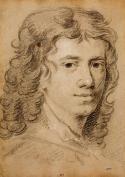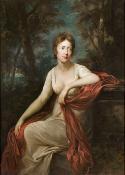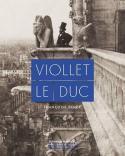Art Of The Day Weekly
#325 - from 5 December 2013 to 11 December 2013

Jean Cousin, dit le Père, Eva Prima Pandora, 16th century, oil on panel, 97 x 150 cm. Paris, musée du Louvre © RMN-Grand Palais (musée du Louvre) /Michel Urtado
IN THE AIR
A celebrity today, unknown tomorrow?
Undoubtedly everyone in the art world will have their attention turned to Art Basel Miami Beach, where the most important galleries will present their iconic artists. Gagosian, Zwirner, or Perrotin will surely be with Koons, Murakami, Sugimoto, Richter and millions of dollars will be involved in record transactions, proving once again that certain sectors defy all and any crisis… Far from this mandatory fair of vanities, the museums do the contrary and bring forward forgotten artists, of which some had been, in their time, admired idols. Who today, in the public at large, remembers Aldegrever, Graff, Ramsay, Minville or Vincent? One must draw a great learning from this, so well said in Latin: Sic transit gloria mundi. Let us simply hope that a century from now brave curators will make the same effort and will pull out some of our contemporaries after they have fallen to oblivion…
10 ARTISTS WORTH REDISCOVERING

Heinrich Aldegrever, Selfportrait at age 35, 1537, engraving on copper © Staatliche Museen zu Berlin, Kupferstichkabinett
1 Aldegrever, in praise of what is minute
BERLIN – A native from Westphalia, he was one of the great masters of German engraving during the Renaissance (1502-1555). He specialized in small formats, and reached true virtuosity in the minute genres. His motifs were widely diffused and were greatly shown on other supports, in particular in Italian maiolica.
• Heinrich Aldegrever at the Gemäldegalerie, from 8 October, 2013 to 19 January 2014.
2 Jean Cousin, a pioneer of the nude
PARIS – The title of the exhibition resembles a joke by Alphonse Allais: “Cousin father and son”. And yet it is their real name, the two Jean Cousin were a mini-dynasty that practically covered the whole XVIth century, and was active in various fields: drawing, sculpture, tapestry, painting on glass. They also hold a record: Eva Prima Pandora, a beautiful antique woman painted on wood by the father in 1550, is considered the first true nude in French painting.
• Jean Cousin père et fils at the Louvre museum, from 16 October 2013 to 13 January 2014
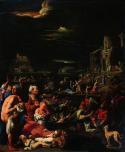
Carlo Saraceni, The Deluge, Sant’Agata sui due Golfi (Massa Lubrense), Benedictine monastery of Saint Paul, oil on canvas, 113,5 x 95 cm.
3 Carlo Saraceni, a powerful artist of the chiaro-oscuro
ROME – Just like his master Caravaggio, who totally eclipsed him, he died young, at the young age of 40. Carlo Saraceni (1579-1620) carried the colors from Venice to Rome, where he received various commissions, in particular from Pope Paul V to decorate the palace of the Quirinale. Some of his works can be seen in situ (in particular his Death of the Virgin, which replaced Caravaggio’s in the church of Santa Maria della Scala) but the exhibition brings together some sixty works, of which some had never been shown before, such as Deluge, hidden in a convent near Sorrento…
• Carlo Saraceni at Palazzo Venezia, from 29 November 2013 to 2 March 2014.
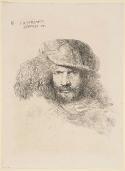
Giovanni Castiglione, A presumed self-portrait, c. 1645-50, etching, 18.8 x 13.8 cm. Royal Collection Trust/© Her Majesty Queen Elizabeth II 2013
4 Castiglione, a genius engraver
LONDON – Grechetto is the name of a grape variety from Umbria but also that of an artist, whose real name was Giovanni Benedetto Castiglione (1609-1665). He left some original oil paintings on paper. But above all he is the inventor of the monotype, that is the print in one single copy) which Degas and later Gauguin used so widely. He produced a group of religious works, canvases, etchings and drawings. A very important series was bought in 1762 by King William III of England from art merchant Joseph Smith, established in Venice. As the Royal collections are the most important in the world, it was time they be presented in a manner worthy of their prestige. This should contribute to repair the lack of attention given to an artist who was the alter ego of Benvenuto Cellini by his adventurous and violent life- he was even accused of murder.
• Castiglione, Lost Genius at the Queens’s Gallery, Buckingham Palace, from 1st November 2013 to 16 March 2014.
5 Ramsay, a prince of portrait artists
GLASGOW – Star on one side of the Channel, unknown on the other: such is the destiny of Allan Ramsay (1713-1784), whose contemporaries held to be a unique portrait artist. The favorite of King George III, he immortalized Flora Mac Donald as well as the surgeon William Hunter, and left behind –as did Graff at eth same period- a true ‘who’s who’ of the country’s fine minds. His taste for drawing penalized him since the genre lost the interest it generated in the XVIIIth century and his works, though multiple, are hardly shown due to their frailty. He himself cut his career short, as from 1770 he dedicated himself to his passion for archaeology and literature.
Allan Ramsay at the Hunterian Art Gallery, from 13 September 2013 to 5 January 2014.
6 Graff and the celebrities of the Enlightment
BERLIN – It was obvious during the retrospective held at the Louvre last Spring that German painting is not well-known in France, and the weakness of the National collections are there to prove it). Among the great portrait artists of the great minds of the Enlightment, we only know Tischbein, who left us his famous Goethe in the Roman countryside . Anton Graff (1736-1813) is of the same caliber: Swiss like Böcklin, he followed most of his créer in Dresden where he painted all the intelligentsia of his time, from Lessing to Schiller.
• Anton Graff at the Alte Nationalgalerie, from 25 October 2013 to 23 February 2014.
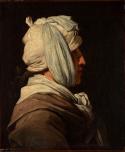
François-André Vincent, Portrait of Lemonnier with bandaged head, 1774 - 1775, oil on canvas, 0,57 x 0,38 m. Marseille, musée des Beaux-Arts © Marseille, musée des Beaux-Arts/Chipault-Soligny
7 Vincent, the first of the Romantics
TOURS – The sub-title of the exhibition says it all “An artist between Fragonard and David”. It crowns a true investigation that began over forty years ago as a thesis directed by André Chastel and Antoine Schnapper -whose David, témoin de son temps(David, a witness of his time) has just been published posthumously by Gallimard-. There is good enough reason for all of one’s senses to be aroused by this painter: his works have been attributed to artists as varied as the above-mentioned Fragonard and David, but also to Géricault, be it Velasquez! And François-André Vincent himself (1746-1816), the son of a miniaturist artist from Geneva, has never been pulled out of the shadows he slipped into more than two centuries ago. Now it has been done and we discover a polymorphic creator, capable of representing romantic encounters in bucolic settings and large historical representations like the Sabines or Henri IV, country allegories, portraits and caricatures, a genre in which he excelled. This selection comes from all over France, from private collections and major institutions such as the Metropolitan Museum in New York or the Certosa di San Martino in Naples. It allows us to have a complete image of his itinerary.
• François-André Vincent, at the musée des Beaux-Arts of Tours, from 19 October 2013 to 19 January 2014 (then at the musée Fabre in Montpellier, from 8 February to 11 May 2014).
8 Miville, a travelling landscape artist
BASEL – A true international itinerary that started in Switzerland, went through Rome and made a pause in Russia (1811-1817), in particular in Crimea, with a constatnly renewed fascination for grandiose landscapes. Such is the destiny of Jakob Christian Miville (1786-1836), a native from Basel who is hardly known and whose work has not been sold very often: only 27 transactions in 25 years have been listed by artprice. A new name to add to the list of globetrotter artists from Napoleon’s Europe…
• Jakob Christoph Miville at the Kunstmuseum, from 16 November 2013 to 16 February 2014.
9 Neder, a report on Austria in the XIXth century
VIENNA – The Belvedere sets up two exhibitions from its rich collections each year to explore the career of neglected artists. Michael Neder (1807-1882) is one of them as is reputation of a representative of the Biedermeier style, the most bourgeois possible, played against him. The life of little people in the XIXth century, peasants, servants or tavern owners, is represented in picturesque and colorful paintings, with numerous material details bring a whole period back to life.
• Michael Neder at the Belvedere, from 18 September 2013 to 19 January 2014.

Darío de Regoyos (1857-1913), Blossoming almond trees, 1905, oil on canvas, 46 x 61 cm. Coleccion Carmen Thyssen-Bornemisza, in deposit at Museo Carmen Thyssen Málaga
10 Regoyos, the first Spanish Impressionist
BILBAO – He is a true cosmopolitan artist. Darío de Regoyos (1857-1913) was a native from the Asturias region, studied in Brussels where he befriended Ensor and Verhaeren, traveled through Europe – Paris, London to meet Whistler, to Italy, then from the Basque country to Andalusia. His paintings bring together various influences: first a Symbolist, Regoyos revealed himself as a pioneer of Impressionism in Spain before being seduced by pointillism and excelling as an engraver. This diversity undoubtedly hurt his fame, and limited is image to that of a brilliant dabbler.
• Darío de Regoyos at the Museo de Bellas Artes, from 7 October 2013 to 26 January 2014.
AUCTIONS

Lot 483. Louis de Monard (1873-1939), bathtub in in Comblanchien stone, 1930. Heigth. 68 x Length. 184 x Depth 88 cm. Estimate: €5000-8000.
Maurice Chevalier's bathtub
PARIS – Fetishists, do not miss this one! Four décades after the death of Maurice Chevalier, the furniture from his home in Marnes-la-Coquette is up for sale by order of the courts. The environment of the man with the straw hat had been set by the devotion of his latest companion, Odette Meslier. Her is, of course, a collection of boaters, of canes, of good wine bottles, of autographed photographs (by Brigitte Bardot or Audrey Hepburn), his 1967 Mercedes, with just 72 978 km at the meter. Themost curious object though is nevetheless the marble bathtub, a totally kitsch monument in which the Frenchie liked to reax while listening to his old songs on his record player. It was sculpted in 1930 by the animal sculptor Louis de Monard (1873-1939) in a block of limestone, and weighed almost one ton. The auctioneers were careful to mention that the buyer would cover the expense of the removal of the object … • Collection Maurice Chevalier at the hotel Drouot on 9 December 2013 (SCP Digard & Pestel-Debord)
BOOKS
Viollet-le-Duc, the return
His reputation is far from crystal clear as he is described as being responsible for all sorts of the artificial styles of the XIXth century, the neo-Gothic in first place, even if other architects left their mark in this field. As we are getting ready to celebrate the 200th anniversary of the birth of Eugène Viollet-le-Duc (1814-1879), this new monographic work reminds us of the person’s extreme diversity. Indeed he invented at Notre-Dame, Pierrefonds or even Carcassonne a middle Ages that never really existed. But he was also the savior of various monuments - the Madeleine of Vézelay among others–which could have disappeared if he had not intervened (commissioned by Mérimée, then an inspector of historical monuments). And the list of his talents, as the author shows us throughout the various chapters, does not end there: he wrote a lot on architecture, designed furniture, was the instigator of the musée des Monuments français and was even a great painter of mountain scenes. It was about time we re-discover Viollet-le-Duc…
• Viollet-le-Duc par Françoise Bercé, Éditions du Patrimoine, 2013, 256 p. , €45.
IN BRIEF
BRUSSELS - The Fin-de-siècle museum will be inaugurated on 6 December 2013.
LONDON - The Turner Prize 2013 was given to French artist Laure Prouvost.
MIAMI - The modern and contemporary art fair, Art Basel Miami Beach, will be held from 5 to 8 December 2013.
PARIS - The famous tapestry of la Dame à la licorne will be reinstalled in a specially rearranged room of the musée de Cluny on 9 December 2013.

